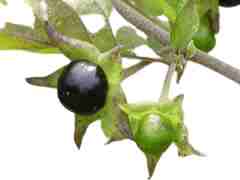What are nightshade berries used for?
Nightshade berries come from plants in the Solanaceae family, which includes a mix of toxic and non-toxic species.
One of the most commonly known nightshade plants is the Deadly Nightshade (Atropa belladonna), but the family also includes edible plants like tomatoes, potatoes, and eggplants.
The uses of these berries vary significantly depending on the plant species.
Deadly Nightshade berries (Atropa belladonna)
 Atropa belladonna is a perennial herbaceous plant that can grow to 1 to 2 meters (3 to 6 feet) in height.
Atropa belladonna is a perennial herbaceous plant that can grow to 1 to 2 meters (3 to 6 feet) in height.
It has large, dark green leaves and produces bell-shaped, purple to greenish flowers. The berries are shiny, black, and about the size of a cherry.
This plant produces dark berries that are highly toxic. All parts of the plant, including the berries, contain tropane alkaloids like atropine and scopolamine, which can be deadly if ingested.
All parts of the plant are highly toxic due to tropane alkaloids like atropine, scopolamine, and hyoscyamine. Ingesting even small amounts of the berries or leaves can be fatal.
The plant is highly toxic, and ingestion of any part of it, including the berries, can be fatal. It’s mostly used in controlled medical contexts and is not recommended for casual use.
Chemical Composition
- Alkaloids:
- Atropine: A tropane alkaloid with anticholinergic properties, affecting the nervous system.
- Scopolamine: Another tropane alkaloid with anticholinergic effects, used for motion sickness and nausea.
- Hyoscyamine: Similar to atropine and scopolamine, with effects on the parasympathetic nervous system.
- Health Risks
- Toxicity: All parts of the plant, including the berries and leaves, are highly toxic if ingested. Symptoms of poisoning include dilated pupils, sensitivity to light, tachycardia, loss of balance, hallucinations, and even death.
- Medical Use: Despite its toxicity, certain alkaloids from Atropa belladonna are used in medicine under strict control. Atropine and scopolamine are used in various medical treatments, including as pre-anesthetic agents, in ophthalmology, and for motion sickness.
- Historical and Medicinal Context
- Historical Use: Historically, belladonna was used in small, controlled doses for its medicinal properties, including as a pain reliever and muscle relaxant.
- Modern Use: In contemporary medicine, alkaloids extracted from the plant are used in very controlled, specific medical contexts.
Tomatillo (Physalis philadelphica)
 Also known as the husk tomato, the tomatillo produces small, green berries encased in a papery husk. These berries unlike deadly nightshade, tomatillos are edible and used in various culinary dishes.
Also known as the husk tomato, the tomatillo produces small, green berries encased in a papery husk. These berries unlike deadly nightshade, tomatillos are edible and used in various culinary dishes.
Tomatillos are typically round and green, though they can also be yellow or purple when ripe. They have smooth, waxy skin and are encased in a thin, papery husk that looks like a lantern.
Tomatillos are widely used in culinary applications, especially in Mexican cuisine. The green berries are encased in a papery husk and are used to make sauces (like salsa verde), soups, and other dishes.
They have a tangy flavor and are rich in vitamins and antioxidants. Tomatillos are safe to eat and are commonly included in various recipes.
Health Benefits of Tomatillo
- Rich in Vitamin C: Tomatillos provide a good amount of vitamin C, which is essential for immune function, skin health, and antioxidant protection.
- Antioxidants: They contain various antioxidants, including vitamin C and flavonoids, which can help protect cells from oxidative damage.
- Fiber Content: The dietary fiber in tomatillos can aid in digestion and help maintain a healthy digestive system.
- Low in Calories: They are low in calories and fat, making them a good choice for weight management and overall health.
Goji Berries (Lycium barbarum)
 Goji berries come from the goji plant, which is a member of the Solanaceae family.
Goji berries come from the goji plant, which is a member of the Solanaceae family.
Goji berries are often dried and used in teas, and soups, or eaten as a snack. They are known for their nutritional benefits and are not toxic.
Goji berries are consumed for their nutritional benefits and are often used in dried form in teas, soups, and as a snack.
They are praised for their high levels of antioxidants, vitamins (particularly vitamin C), and potential health benefits, including boosting immune function and improving skin health.
Goji berries are generally considered safe and are not toxic.
Health Benefits of Goji berries
- Vitamins and Minerals: Goji berries are rich in vitamins like vitamin C, vitamin A, and several B vitamins. They also contain minerals such as iron, zinc, and selenium.
- Antioxidants: They are high in antioxidants, including carotenoids, zeaxanthin, and polyphenols, which help combat oxidative stress and inflammation.
- Fiber: They are a good source of dietary fiber, which aids in digestion and helps maintain a healthy gut.
- Immune Support: The high vitamin C content and antioxidants support the immune system and help the body fight off illnesses.
- Eye Health: Zeaxanthin and other antioxidants may help protect the eyes from age-related damage and improve vision.
- Skin Health: The vitamins and antioxidants can contribute to healthier skin, potentially reducing signs of aging.
- Blood Sugar and Weight Management: Some studies suggest that goji berries might help regulate blood sugar levels and support weight loss efforts, though more research is needed in these areas.
Chili Peppers (Capsicum species)
 While not commonly recognized for their berries, the fruits of chili pepper plants are technically berries. These peppers come in various shapes, sizes, and heat levels and are widely used in cooking.
While not commonly recognized for their berries, the fruits of chili pepper plants are technically berries. These peppers come in various shapes, sizes, and heat levels and are widely used in cooking.
Although not typically referred to as “berries,” the fruits of chili pepper plants are used extensively in cooking to add heat and flavor.
They can be used fresh, dried, or powdered. Capsaicin, the compound responsible for their spiciness, has also been used in topical pain relief creams and supplements for its analgesic properties.
While not toxic, chili peppers can cause irritation or discomfort if handled improperly or consumed in excessive amounts.
Health Benefits of Chili Peppers
- Capsaicin: The compound responsible for the heat in chili peppers. Capsaicin has been studied for its potential benefits, including pain relief, metabolism boost, and anti-inflammatory properties.
- Antioxidants: Chili peppers are rich in antioxidants, including vitamin C, beta-carotene, and flavonoids, which help neutralize free radicals and reduce oxidative stress.
- Immune Support: High levels of vitamin C contribute to a robust immune system and overall health.
- Anti-Inflammatory: Capsaicin has been shown to have anti-inflammatory properties, potentially benefiting conditions like arthritis.
- Metabolism Boost: Capsaicin may increase metabolism and aid in weight management by enhancing thermogenesis and fat oxidation.
- Pain Relief: Capsaicin is often used in topical creams for its analgesic effects, helping to relieve pain.
Conclusion: Especially those with toxic berries like the Deadly Nightshade, are dangerous if consumed improperly. Always ensure proper identification and understand the risks before handling or consuming any plant parts. Staying in the nightshade family is especially important to avoid toxicity and make the most of their beneficial properties
